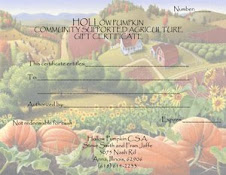 We though everyone would like to see what's growing on the farm this spring. We have a whole lot of garlic, spinach and the peas are just coming up. Once again, Ryan Campbell came out to help. Steve and Ryan spread compost and planted onions today.
We though everyone would like to see what's growing on the farm this spring. We have a whole lot of garlic, spinach and the peas are just coming up. Once again, Ryan Campbell came out to help. Steve and Ryan spread compost and planted onions today.Above is a picture of the garlic field.
Steve and I took a look at the Asparagus today and decided that they are just too thin this year to include in the C.S.A. shares this year. If you read the earlier post about growing asparagus you will remember that it usually takes three years from the time of planting before you would see an abundance of mature asparagus that is acceptable for harvest. These asparagus plants were planted last season. If you harvest imature asparagus you jeapordize the next years crop growth. It is best to wait until you have a majority of nice sized (diameter wise) asparagus. Good asparagus is well worth the wait. We may see some harvestable asparagus next season...let us hope.
We have our little greenhouse filled with many seedlings waiting to be brought outside for planting. Spring is really popping here on the farm.

One of our beautiful asparagus teaching us a lesson in patience.
below: our bounty of spinach and Farmer Steve, himself, in the trenches spreading compost.











